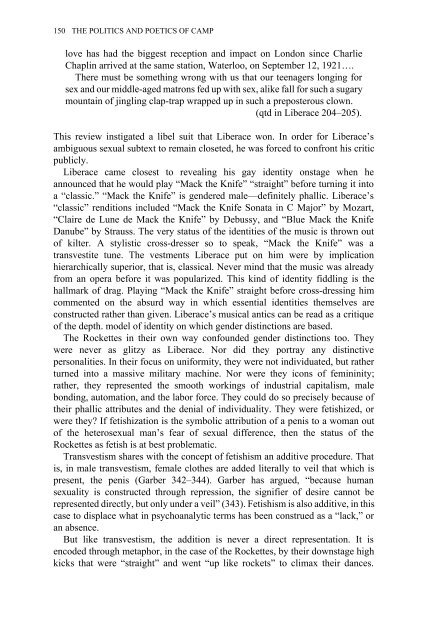Edited by Moe Meyer - Get a Free Blog
Edited by Moe Meyer - Get a Free Blog
Edited by Moe Meyer - Get a Free Blog
You also want an ePaper? Increase the reach of your titles
YUMPU automatically turns print PDFs into web optimized ePapers that Google loves.
150 THE POLITICS AND POETICS OF CAMP<br />
love has had the biggest reception and impact on London since Charlie<br />
Chaplin arrived at the same station, Waterloo, on September 12, 1921….<br />
There must be something wrong with us that our teenagers longing for<br />
sex and our middle-aged matrons fed up with sex, alike fall for such a sugary<br />
mountain of jingling clap-trap wrapped up in such a preposterous clown.<br />
(qtd in Liberace 204–205).<br />
This review instigated a libel suit that Liberace won. In order for Liberace’s<br />
ambiguous sexual subtext to remain closeted, he was forced to confront his critic<br />
publicly.<br />
Liberace came closest to revealing his gay identity onstage when he<br />
announced that he would play “Mack the Knife” “straight” before turning it into<br />
a “classic.” “Mack the Knife” is gendered male—definitely phallic. Liberace’s<br />
“classic” renditions included “Mack the Knife Sonata in C Major” <strong>by</strong> Mozart,<br />
“Claire de Lune de Mack the Knife” <strong>by</strong> Debussy, and “Blue Mack the Knife<br />
Danube” <strong>by</strong> Strauss. The very status of the identities of the music is thrown out<br />
of kilter. A stylistic cross-dresser so to speak, “Mack the Knife” was a<br />
transvestite tune. The vestments Liberace put on him were <strong>by</strong> implication<br />
hierarchically superior, that is, classical. Never mind that the music was already<br />
from an opera before it was popularized. This kind of identity fiddling is the<br />
hallmark of drag. Playing “Mack the Knife” straight before cross-dressing him<br />
commented on the absurd way in which essential identities themselves are<br />
constructed rather than given. Liberace’s musical antics can be read as a critique<br />
of the depth. model of identity on which gender distinctions are based.<br />
The Rockettes in their own way confounded gender distinctions too. They<br />
were never as glitzy as Liberace. Nor did they portray any distinctive<br />
personalities. In their focus on uniformity, they were not individuated, but rather<br />
turned into a massive military machine. Nor were they icons of femininity;<br />
rather, they represented the smooth workings of industrial capitalism, male<br />
bonding, automation, and the labor force. They could do so precisely because of<br />
their phallic attributes and the denial of individuality. They were fetishized, or<br />
were they? If fetishization is the symbolic attribution of a penis to a woman out<br />
of the heterosexual man’s fear of sexual difference, then the status of the<br />
Rockettes as fetish is at best problematic.<br />
Transvestism shares with the concept of fetishism an additive procedure. That<br />
is, in male transvestism, female clothes are added literally to veil that which is<br />
present, the penis (Garber 342–344). Garber has argued, “because human<br />
sexuality is constructed through repression, the signifier of desire cannot be<br />
represented directly, but only under a veil” (343). Fetishism is also additive, in this<br />
case to displace what in psychoanalytic terms has been construed as a “lack,” or<br />
an absence.<br />
But like transvestism, the addition is never a direct representation. It is<br />
encoded through metaphor, in the case of the Rockettes, <strong>by</strong> their downstage high<br />
kicks that were “straight” and went “up like rockets” to climax their dances.


